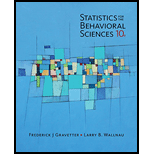
Statistics for The Behavioral Sciences (MindTap Course List)
10th Edition
ISBN: 9781305504912
Author: Frederick J Gravetter, Larry B. Wallnau
Publisher: Cengage Learning
expand_more
expand_more
format_list_bulleted
Concept explainers
Textbook Question
Chapter 18, Problem 3P
- In problem 9 in Chapter 17, we described a study demonstrating that the colored is often associated with male dominance. Hill and Barton (2005) monitored the outcome of four combat sports, (boxing Tae Kwon Do, Greco-Roman wrestling, and freestyle wrestling) during the 2004 Olympic Games and found that participants wearing red outfits won significantly more often than those wearing blue.
- If athletes wearing red won 31 out of 50 matches is that sufficient to be significantly more than would be expected by chance? Use a two-tai led test with a = .05.
- If 62 out of 100 wearing red won, is that enough to be significant using a two-tailed test with a =.05.
- Note that the percentage of winning for red uniforms in part is identical to the percentage in part b (31/50= 62/100 = 62%) however, one is significant and the other is not. Explain why the two sample lead to different conclusions.
- The color red is often associated with anger and male dominance. Based on this observation, Hil1 and Barton (2005) monitored the outcome of four combat sports (boxing, tae kwan do, Greco-Roman wrestling, and freestyle wrestling, during the 2004 Olympic games and found that participants wearing red outfits won significantly more often than those wearing blue.
- In 50 wrestling matches involving red versus blue suppose that the red outfit won 31 times and lost 19 times. Is this sufficient to conclude that red wins significantly more than would be expected by chance? Test at the .05 level of significance. b. In 100 matches, suppose red won 62 times and lost 38. Is this sufficient to conclude that red wins sig nificantly more than would be expected by chance? Again, use a = .05.
c. Note that the winning percentage for red uniforms in part a is identical to the percentage in part b (31/50=62/100=62%). Although the two samples have an identical winning percentage, one is significant and the other is not. Explain why the two samples lead to different conclusions.
Expert Solution & Answer
Want to see the full answer?
Check out a sample textbook solution
Chapter 18 Solutions
Statistics for The Behavioral Sciences (MindTap Course List)
Ch. 18 - 1. Insurance companies charge young drivers more...Ch. 18 - 2. Güven, Elaimis, Binokay, and Tan (2003) studied...Ch. 18 - In problem 9 in Chapter 17, we described a study...Ch. 18 - 4. Problems 5 and 6 in Chapter 17 cited a study...Ch. 18 - 5. A researcher would like to determine whether...Ch. 18 - 6. A recent survey of practicing psychotherapists...Ch. 18 - 7. In 2005, Fung et al. published a study...Ch. 18 - 8. In problem 13 in Chapter 9, wepresented a study...Ch. 18 - Prob. 9PCh. 18 - Prob. 10P
Ch. 18 - Prob. 11PCh. 18 - 12. One of the original methods for testing ESP...Ch. 18 - Prob. 13PCh. 18 - Prob. 14PCh. 18 - 15. In Example 11.2 (p. 343) we presented a...Ch. 18 - Stressful or traumatic experiences can often...Ch. 18 - Prob. 17PCh. 18 - Prob. 18PCh. 18 - Prob. 19PCh. 18 - In Problem 14 in Chapter 11, we described a study...Ch. 18 - In problem 13 in Chapter 17, we Discussed a study...Ch. 18 - Prob. 22PCh. 18 - Prob. 23PCh. 18 - Prob. 24PCh. 18 - Prob. 25P
Knowledge Booster
Learn more about
Need a deep-dive on the concept behind this application? Look no further. Learn more about this topic, statistics and related others by exploring similar questions and additional content below.Recommended textbooks for you
 MATLAB: An Introduction with ApplicationsStatisticsISBN:9781119256830Author:Amos GilatPublisher:John Wiley & Sons Inc
MATLAB: An Introduction with ApplicationsStatisticsISBN:9781119256830Author:Amos GilatPublisher:John Wiley & Sons Inc Probability and Statistics for Engineering and th...StatisticsISBN:9781305251809Author:Jay L. DevorePublisher:Cengage Learning
Probability and Statistics for Engineering and th...StatisticsISBN:9781305251809Author:Jay L. DevorePublisher:Cengage Learning Statistics for The Behavioral Sciences (MindTap C...StatisticsISBN:9781305504912Author:Frederick J Gravetter, Larry B. WallnauPublisher:Cengage Learning
Statistics for The Behavioral Sciences (MindTap C...StatisticsISBN:9781305504912Author:Frederick J Gravetter, Larry B. WallnauPublisher:Cengage Learning Elementary Statistics: Picturing the World (7th E...StatisticsISBN:9780134683416Author:Ron Larson, Betsy FarberPublisher:PEARSON
Elementary Statistics: Picturing the World (7th E...StatisticsISBN:9780134683416Author:Ron Larson, Betsy FarberPublisher:PEARSON The Basic Practice of StatisticsStatisticsISBN:9781319042578Author:David S. Moore, William I. Notz, Michael A. FlignerPublisher:W. H. Freeman
The Basic Practice of StatisticsStatisticsISBN:9781319042578Author:David S. Moore, William I. Notz, Michael A. FlignerPublisher:W. H. Freeman Introduction to the Practice of StatisticsStatisticsISBN:9781319013387Author:David S. Moore, George P. McCabe, Bruce A. CraigPublisher:W. H. Freeman
Introduction to the Practice of StatisticsStatisticsISBN:9781319013387Author:David S. Moore, George P. McCabe, Bruce A. CraigPublisher:W. H. Freeman

MATLAB: An Introduction with Applications
Statistics
ISBN:9781119256830
Author:Amos Gilat
Publisher:John Wiley & Sons Inc

Probability and Statistics for Engineering and th...
Statistics
ISBN:9781305251809
Author:Jay L. Devore
Publisher:Cengage Learning

Statistics for The Behavioral Sciences (MindTap C...
Statistics
ISBN:9781305504912
Author:Frederick J Gravetter, Larry B. Wallnau
Publisher:Cengage Learning

Elementary Statistics: Picturing the World (7th E...
Statistics
ISBN:9780134683416
Author:Ron Larson, Betsy Farber
Publisher:PEARSON

The Basic Practice of Statistics
Statistics
ISBN:9781319042578
Author:David S. Moore, William I. Notz, Michael A. Fligner
Publisher:W. H. Freeman

Introduction to the Practice of Statistics
Statistics
ISBN:9781319013387
Author:David S. Moore, George P. McCabe, Bruce A. Craig
Publisher:W. H. Freeman
Bayes' Theorem 1: Introduction and conditional probability; Author: Dr Nic's Maths and Stats;https://www.youtube.com/watch?v=lQVkXfJ-rpU;License: Standard YouTube License, CC-BY
What is Conditional Probability | Bayes Theorem | Conditional Probability Examples & Problems; Author: ACADGILD;https://www.youtube.com/watch?v=MxOny_1y2Q4;License: Standard YouTube License, CC-BY
Bayes' Theorem of Probability With Tree Diagrams & Venn Diagrams; Author: The Organic Chemistry Tutor;https://www.youtube.com/watch?v=OByl4RJxnKA;License: Standard YouTube License, CC-BY
Bayes' Theorem - The Simplest Case; Author: Dr. Trefor Bazett;https://www.youtube.com/watch?v=XQoLVl31ZfQ;License: Standard Youtube License